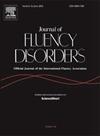Cortical emotional reactivity, caregiver-reported emotional control, and stuttering frequency in young children
IF 2.1
3区 医学
Q1 AUDIOLOGY & SPEECH-LANGUAGE PATHOLOGY
引用次数: 0
Abstract
Purpose
The present study aimed to determine whether cortical associates of emotional reactivity and caregiver-reported emotional control skills are associated with stuttered speech in young children who do (CWS) and do not stutter (CWNS).
Method
Twenty young CWS and 24 young CWNS passively viewed neutral and affective pictures while their event-related potentials (ERPs) were recorded. Children’s speech fluency was assessed during a free-play conversational speech sample before the ERP task. Participants’ caregivers completed the Behavior Rating Inventory of Executive Function (BRIEF).
Results
For CWS and CWNS, greater cortical reactivity to unpleasant pictures was associated with higher stuttering frequency. Parents of CWS rated their children poorer on the Emotional Control dimension of the BRIEF than parents of CWNS. However, the between-group difference on Emotional Control was no longer significant when group differences in expressive language scores were taken into account. Within-group analyses revealed that poorer Emotional Control scores were associated with higher stuttering frequency for CWS. Lastly, for CWS, poorer Emotional Control scores on BRIEF were associated with greater cortical reactivity to unpleasant pictures.
Conclusions
Overall, findings replicate those of previous studies that reported a significant association between stuttering and emotion-related behavioral and physiological measures. Further, this study extends past work and provides the first evidence that cortical measures of emotional reactivity are associated with stuttering frequency. Potential mechanisms that may explain the nature of the association between emotional processes and stuttering frequency are discussed but must await further study to be elucidated.
皮层情绪反应,照顾者报告的情绪控制和幼儿口吃频率
目的本研究旨在确定情绪反应和照顾者报告的情绪控制技能的皮质关联是否与幼儿口吃(CWS)和非口吃(CWNS)言语口吃有关。方法选取20例年轻脑卒中患者和24例年轻脑卒中患者被动观看中性和情感图片,记录他们的事件相关电位。在ERP任务之前,在自由游戏会话语音样本中评估儿童的语言流畅性。参与者的照顾者完成执行功能行为评定量表(BRIEF)。结果CWS和CWNS患者对不愉快画面的皮质反应性越强,口吃频率越高。在BRIEF的情绪控制维度上,有心理障碍的父母比无心理障碍的父母得分低。然而,当考虑到表达语言得分的组间差异时,情绪控制的组间差异不再显著。组内分析显示,较差的情绪控制得分与CWS患者较高的口吃频率相关。最后,对于CWS来说,BRIEF的情绪控制得分越低,大脑皮层对不愉快画面的反应就越强烈。总的来说,研究结果重复了先前的研究报告,即口吃与情绪相关的行为和生理指标之间存在显著关联。此外,这项研究扩展了过去的工作,并提供了第一个证据,证明情绪反应的皮层测量与口吃频率有关。讨论了可能解释情感过程和口吃频率之间联系本质的潜在机制,但必须等待进一步的研究来阐明。
本文章由计算机程序翻译,如有差异,请以英文原文为准。
求助全文
约1分钟内获得全文
求助全文
来源期刊

Journal of Fluency Disorders
AUDIOLOGY & SPEECH-LANGUAGE PATHOLOGY-REHABILITATION
CiteScore
3.70
自引率
14.30%
发文量
23
审稿时长
>12 weeks
期刊介绍:
Journal of Fluency Disorders provides comprehensive coverage of clinical, experimental, and theoretical aspects of stuttering, including the latest remediation techniques. As the official journal of the International Fluency Association, the journal features full-length research and clinical reports; methodological, theoretical and philosophical articles; reviews; short communications and much more – all readily accessible and tailored to the needs of the professional.
 求助内容:
求助内容: 应助结果提醒方式:
应助结果提醒方式:


